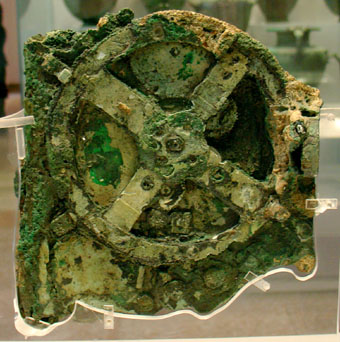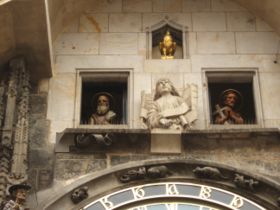
Here's a mystery regarding the Antikythera mechanism. If you've seen photos of the largest surviving piece of this ancient calculator (such as the one on the left), you'll be familiar with its largest gearwheel. It's clearly recognisable because it has four pieces cut out of it, giving it wide spokes in the shape of a cross. Antikythera scholars call this wheel b1.
The four spokes on b1 have some small holes in them, suggesting that some other structure was once attached to - and therefore carried around on - this wheel. But what? And for that matter, why does this wheel even have spokes? All of the other surviving gearwheels in the mechanism are solid discs.
Back in the 1990s, the mechanic and curator Michael Wright came up with the idea that b1 carried other gearwheels - a type of gearing known as epicyclic - and that this was used to model the motions of the planets. The Greeks thought that each planet moved in little circles, called epicycles, as it traced a larger orbit around the Earth. Wright built a model to show how these gears would have worked (see video).
As for the spokes, Wright reckons that the maker of the device cut out the spaces in this large wheel simply to save on valuable bronze.
Although no trace of Wright's epicyclic gearwheels survives, it's a brilliant and plausible suggestion - the inscriptions on the mechanism suggest that it did model the planets somehow - and other Antikythera experts have assumed that he was probably correct.
But now there's a rival theory. I wrote last week about a study suggesting that the Antikythera mechanism didn't model the epicycles of the planets after all - that it was actually modelling earlier astronomical theories.
So if this cross-shaped gearwheel wasn't carrying around epicyclic gearwheels, what was it carrying?
Jim Evans, an expert in the history of astronomy at the University of Puget Sound in Tacoma, Washington, and the lead author of the latest study, suggests that four little statues or figurines could have been mounted on the spokes of b1, perhaps representing the four seasons, or winds associated with those seasons.
 As b1 turned in the course of a year, one after the other of these figures would have appeared in a small window on the front face of the device. For example, the Greeks associated Boreas, god of the north wind, with winter; Zephyros, god of the west wind, with spring; and the Etesian winds with later in the summer.
As b1 turned in the course of a year, one after the other of these figures would have appeared in a small window on the front face of the device. For example, the Greeks associated Boreas, god of the north wind, with winter; Zephyros, god of the west wind, with spring; and the Etesian winds with later in the summer.
As well as explaining what b1 was carrying, Evans says this theory also explains why it had spokes.
"The figurines would have ridden around on b1, and would usually have been flat against the wheel," he told me. "When one of them reached the window, a mechanism attached to the plate below b1 would have pushed an arm up through one of those large gaps in b1, to cause the figure to come forward and appear out of the window." He adds that he and his colleagues have been working on some mechanical designs for exactly how this might have worked.
I love the idea of little deities popping up through a window in the front of the Antikythera mechanism, like the world's first cuckoo clock! But how likely is this?
When I asked Alexander Jones, a historian of astronomy at the Institute for the Study of the Ancient World who has studied the Antikythera mechanism, he described the idea as "a little bit desperate". And Evans himself admits that the whole thing is "highly conjectural".
That said, Evans points out that displays involving moving figures were very popular in Medieval astronomical clocks (for example see detail from the Prague astronomical clock, above), which may be directly descended from devices like the Antikythera mechanism. And we know that the ancient Greeks did use automated figures too. For example, Hero of Alexandria, working in the first century AD, was famous for his steam-powered devices, that among other things drove miniature people, animals and birds.
 The idea also reminds me of the Tower of the Winds (which I've blogged about before). It's an octagonal tower in the ancient Greek marketplace in Athens and it dates from the first or second century BC - just the same time as the Antikythera mechanism. It originally had a weather vane on top, and you can still see carvings of the gods associated with the eight winds at the top of its outer walls (see pic, left). Inside was an impressive water clock.
The idea also reminds me of the Tower of the Winds (which I've blogged about before). It's an octagonal tower in the ancient Greek marketplace in Athens and it dates from the first or second century BC - just the same time as the Antikythera mechanism. It originally had a weather vane on top, and you can still see carvings of the gods associated with the eight winds at the top of its outer walls (see pic, left). Inside was an impressive water clock.
No physical trace of this clock remains save for the holes in the floor where it once stood, but Derek Price - a historian of science who also spent decades working on the Antikythera mechanism - reconstructed its workings in the 1960s. From the positions of the floor markings he concluded that this water clock was of a known type that included a revolving astronomical display, and he suggested that it probably had moving figures that struck the hours.
So although there is no direct evidence for the existence of pop-up figures in the Antikythera mechanism, the idea is at least possible, consistent with the surviving remains of the device, and in the spirit of the type of thing that Greeks were doing at the time. Evans also says he hopes that his suggestion will serve as a reminder to keep an open mind about the mechanism's features: "An ancient mechanic may have seen more possible uses for those holes on the spokes of b1, as well as the spaces between the spokes, than we might."